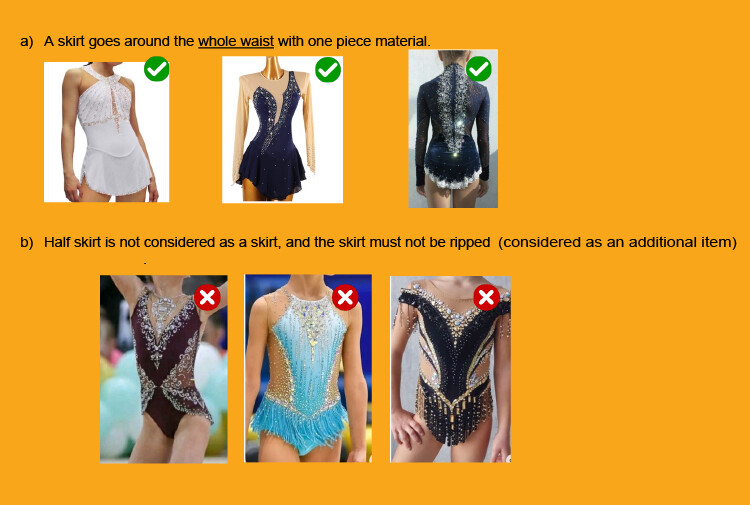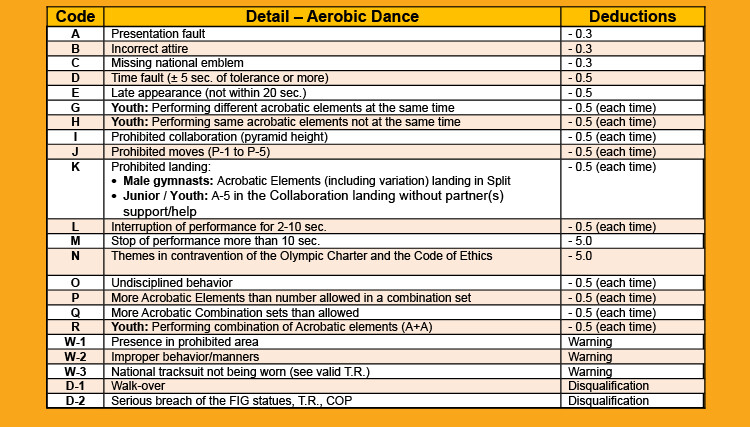AEROBIC DANCE (8 competitors)
This part should be read in conjunction with the main CoP, Part 2.
If not written in this part, apply the CoP.
This part should be read in conjunction with the main CoP, Part 2.
If not written in this part, apply the CoP.

- Group Choreography of 8 competitors (male/female/mixed), utilizing the Aerobic Dance movements more freely than other categories.
- The Choreography must have a “THEME” and must express within the choreography.
- The routine must include 32 to 64 counts of 2nd STYLE (any Style of Dance are allowed) that is different from the rest of the choreography.
- One of the important aspects is the SYNCHRONIZATION of all members as a unit.
- The routine may include acrobatic and/or difficulty elements, but they will not receive any value.
< AGE >
- Senior: 18 years or more in the year of the competition
- Junior: 15-17 in the year of the competition
- Youth: 12-14 in the year of the competition
< COMPETITION AREA >
- 10m x 10m
< MUSIC LENGTH >
- Senior & Junior : 1’ 25” ± 5”
- Youth : 1’ 15” ± 5”
< MUSIC >
- Any style of music (world famous or well-known music is recommended)
< COLLABORATION >
- Must show minimum of 3 collaborations in the whole routine.
< JUDGES >
CJP (1), E-Jury (4-6), A-Jury (4-6), L-Jury (2), T-Jury (1)
< DRESS CODE >
- Athletic Appearance.
- Unitard or Two-piece leotard (Pants, long leggings, shorts, and tops) is allowed.
- The underwear must not be seen.
- Correct support must be worn.
- The attire can be different between the members but should be harmonized.
- Too large or too loose clothes are not allowed. The body alignment must be seen.
- The competitor must wear supportive aerobic or sports shoes.
- Hair must be neat and secured but must not touch the face or the shoulders. Short ponytails are allowed.
- Additional items (tubes, sticks, balls, etc.), and accessories (belts, braces, bands, etc.) are not allowed.
- Attire depicting war, violence or religious themes is forbidden.
- No sequins allowed for men.
- A skirt that does not fall further than the pelvic area over the leotard, tights or the unitard is allowed.
- The style of the skirt (cut or decorations) is free, but the look of a ballet “tutu” is forbidden.

- Body paint is not allowed.
- Only skin color taping is allowed (no braces/grips).
- The pelvic/crotch area must be covered with non-transparent, non-skin colored material up to the hip bones.
- Leotards that are almost all skin colored (see Glossary) are not allowed. It appears as nudity on TV.

< FUNCTION >
See Part 2
< ACROBATIC ELEMENTS >
The routine may include movements from other disciplines (without excessive use) well integrated into the Choreography.
Senior / Junior:
< Single Acrobatic Element >
There is no limitation of numbers to perform the single Acrobatic Element in the whole routine.
A single Acrobatic Element can be performed at the same time, in cannon or at different time.
There is no counting of which Acrobatic Elements performed.
Youth:
Only A-1 to A-4 Acrobatic element is allowed to perform. A-5 is not allowed to perform except in the collaboration but must land with partner(s) support/help.
If A-5 is performed without collaboration, it will be considered as a prohibited move.
If all 8 competitors perform the Acrobatic element, this must be performed at the same time with the same element.
< COMBINATION OF ACROBATIC ELEMENTS >
Senior / Junior:
Maximum of 2 Acrobatic Elements in one combination set may be performed at the same time (number of gymnasts are optional).
It is possible to perform different Acro Combination sets within members but must be at the same time.
Example: NO Deduction
3 gymnasts: A1 + A5
4 gymnasts: A1 + A4
Number of Combination sets allowed in the whole routine (A + A):
Senior: 3 sets
Junior: 2 sets
Examples:
Round off + flic flac + salto = DEDUCTION
Round off + salto = NO DEDUCTION
No combination of Acrobatic Elements is allowed.
< PROHIBITED COLLABORATION >
Junior / Youth:
Make deductions and penalties by the Chair of Judges Panel:
See Part 2
< ACROBATIC ELEMENTS >
The routine may include movements from other disciplines (without excessive use) well integrated into the Choreography.
Senior / Junior:
< Single Acrobatic Element >
There is no limitation of numbers to perform the single Acrobatic Element in the whole routine.
A single Acrobatic Element can be performed at the same time, in cannon or at different time.
There is no counting of which Acrobatic Elements performed.
Youth:
Only A-1 to A-4 Acrobatic element is allowed to perform. A-5 is not allowed to perform except in the collaboration but must land with partner(s) support/help.
If A-5 is performed without collaboration, it will be considered as a prohibited move.
If all 8 competitors perform the Acrobatic element, this must be performed at the same time with the same element.
< COMBINATION OF ACROBATIC ELEMENTS >
Senior / Junior:
Maximum of 2 Acrobatic Elements in one combination set may be performed at the same time (number of gymnasts are optional).
It is possible to perform different Acro Combination sets within members but must be at the same time.
Example: NO Deduction
3 gymnasts: A1 + A5
4 gymnasts: A1 + A4
Number of Combination sets allowed in the whole routine (A + A):
Senior: 3 sets
Junior: 2 sets
Examples:
Round off + flic flac + salto = DEDUCTION
Round off + salto = NO DEDUCTION
- Combination of 2 Acrobatic Elements (A+A) is allowed 3 times for Senior and 2 times for Junior in the whole routine.
No combination of Acrobatic Elements is allowed.
< PROHIBITED COLLABORATION >
- Pyramid height of the collaboration must not be higher than 2 persons standing in vertical position if included in static position.
Junior / Youth:
- Acrobatic elements (A5) in the Collaboration landing without partner(s) support/help.
Make deductions and penalties by the Chair of Judges Panel:


< FUNCTION > (See also Part 2)
All movements must be performed with maximum precision (perfection). Any deviation will be deducted from 10.0 points with increments of 0.1 point.
Evaluate the competitor with weakest or larger mistake as an error.
The E-Jury evaluates the Technical Skills of the whole routine from beginning till the end of the following movements (start / end positions included):
< ERRORS >
All movements must be performed with maximum precision (perfection). Any deviation will be deducted from 10.0 points with increments of 0.1 point.
Evaluate the competitor with weakest or larger mistake as an error.
The E-Jury evaluates the Technical Skills of the whole routine from beginning till the end of the following movements (start / end positions included):
- Synchronization (key to AD)
- AMP Dance Sequences technique (including “2nd Style”)
- Transitions & Links
- Partnerships & Collaborations
- Elements (Optional of Difficulty & Acrobatic)
< ERRORS >

< CRITERIA AND DEDUCTION >
Deductions for Difficulty Elements / Acrobatic Elements (optional)
Evaluate technical skills of each element performed
Deductions for Difficulty Elements / Acrobatic Elements (optional)
Evaluate technical skills of each element performed

Deductions for Choreography
Evaluate perfect Execution with maximum precision while performing AMP Dance sequences, 2nd Style, transitions and Partnerships.
Evaluate perfect Execution with maximum precision while performing AMP Dance sequences, 2nd Style, transitions and Partnerships.

Deductions for Synchronization (no limit)
Evaluate all the competitors performing all movements with identical range of motion, precise timing, and same quality.
Evaluate all the competitors performing all movements with identical range of motion, precise timing, and same quality.




< FUNCTION > (See also Part 2)
The A-Jury evaluates all components of Choreography that matches perfectly with music and theme to transform a sport exercise into an artistic performance with creative and unique characteristics by respecting the specificity of Aerobic Gymnastics in Dance Style.
<Routine Components>
< THEME >
The routine must have a “THEME”. It should give a story to the choreography. Theme must be expressed with the movements and music (respecting the sport manner of Aerobic Gymnastics). The team must present choreography as a unit. A routine without “Theme”, Artistry Deduction of -0.5 will apply.
< AMP Sequences >
With respect of the specificity of Aerobic Gymnastics, AMP Sequences should be performed more freely. This does not mean to be moving body without control. The body must be in control with variety of movements throughout the routine.
Utilizing whole body and head and move like in a Dance. This should not be like a robotic movement and not a Dance in a Dance Style or perform like other categories (IM/IW/MP/TR/GR) of Aerobic Gymnastics.
The routine must include minimum of 6 AMP sets (excluding 2nd Style).
< 2nd STYLE >
In AD, the Block of AMP sets are replaced with the 2nd Style. Therefore, the Block of AMP sets are not required.
The routine must include 32 to 64 counts of “2nd Style” (Any Style of Dance with same or different steps within the members are allowed) that is different from the rest of the choreography. The 2nd Style must be well integrated and should not be separated from the main choreography.
This will be evaluated as same system as the Block of AMP sets.
The A-Jury evaluates all components of Choreography that matches perfectly with music and theme to transform a sport exercise into an artistic performance with creative and unique characteristics by respecting the specificity of Aerobic Gymnastics in Dance Style.
<Routine Components>
- AMP Sequences in Dance Style
- 2nd Style
- Difficulty / Acrobatic Elements (optional)
- Transitions / Links
- Partnerships / Collaboration
- Formation / Space
< THEME >
The routine must have a “THEME”. It should give a story to the choreography. Theme must be expressed with the movements and music (respecting the sport manner of Aerobic Gymnastics). The team must present choreography as a unit. A routine without “Theme”, Artistry Deduction of -0.5 will apply.
< AMP Sequences >
With respect of the specificity of Aerobic Gymnastics, AMP Sequences should be performed more freely. This does not mean to be moving body without control. The body must be in control with variety of movements throughout the routine.
Utilizing whole body and head and move like in a Dance. This should not be like a robotic movement and not a Dance in a Dance Style or perform like other categories (IM/IW/MP/TR/GR) of Aerobic Gymnastics.
The routine must include minimum of 6 AMP sets (excluding 2nd Style).
< 2nd STYLE >
In AD, the Block of AMP sets are replaced with the 2nd Style. Therefore, the Block of AMP sets are not required.
The routine must include 32 to 64 counts of “2nd Style” (Any Style of Dance with same or different steps within the members are allowed) that is different from the rest of the choreography. The 2nd Style must be well integrated and should not be separated from the main choreography.
This will be evaluated as same system as the Block of AMP sets.
- Music (max. 2.0 pts)
- Dance Content (max. 2.0 pts)
- General Content (max. 2.0 pts)
- Artistic Routine (max. 2.0 pts)
- Performance (max. 2.0 pts)


















